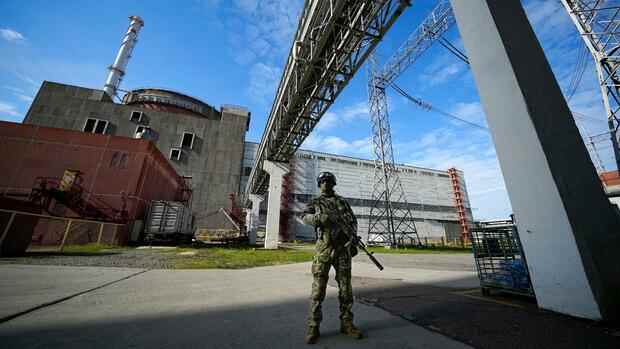Russian troops occupied the power plant in early March.
(Photo: dpa)
Berlin The contested Ukrainian nuclear power plant in Zaporizhia has been keeping the world in suspense for weeks. Inspectors from the International Atomic Energy Agency (IAEA) arrived there for the first time on Thursday. The team led by IAEA Director General Rafael Grossi reached the facility in the early afternoon.
Russian troops have been occupying Europe’s largest nuclear power plant since March 4th. From there they regularly shell the opposite bank of the Dnieper River, which is held by Ukraine.
Two of the plant’s six reactors were still running on Wednesday. On Thursday morning, the penultimate block was also taken off the grid after attacks by Russian helicopters, according to the Ukrainian nuclear power plant operator Energoatom.
In order to secure reactor block five, a diesel generator had to be switched on after the emergency shutdown. Because the power line was also destroyed. Experts consider this to be alarming: without electricity for the necessary cooling systems, there is a risk of nuclear meltdown in nuclear power plants.
Top jobs of the day
Find the best jobs now and
be notified by email.
According to Energoatom, Russia wants to completely disconnect the nuclear plant from the Ukrainian power grid and divert the electricity produced there to the Black Sea peninsula of Crimea, which was annexed by Russia.
According to Western experts, in the run-up to the IAEA inspection, Russia had initiated a veritable propaganda campaign. Putin’s spokesman, Dmitry Peskov, claimed that Ukraine was doing everything it could to prevent General Director Grossi’s mission.
The Ukrainian army made an attempt with speedboats to cross to the Russian-occupied side of the Dnieper River. Allegedly, the plan was to retake the power plant and thwart the inspection. However, Moscow was unable to provide any evidence for this assertion by the Russian army leadership. Ukraine denied a recapture attempt.
Threats to the Ukrainian employees
At the same time, the Ukrainian secret service SBU reported on clean-up operations: before the IAEA visit, the occupiers removed unwelcome Ukrainian workers from the power plant, they said. Her fate and current whereabouts are unknown.
Remaining Ukrainian employees are also said to have been massively attacked by Russian soldiers. They have been threatened with harsh penalties if they make statements to the inspectors that are not in Russia’s interests. Some Ukrainians were even tortured, said Energodar Mayor Dmitro Orlov. Before he was elected mayor, he had worked at the power plant himself.
Allegedly, certain Ukrainian employees at the power plant are being kept away from the team.
(Photo: dpa)
According to Orlov, during the visit of the 14-strong IAEA delegation, the presence of Ukrainian employees should be reduced to a minimum at the behest of the Russians. At the same time, orders were placed to place Russian representatives in the clothes of the Ukrainian power plant operator Energoatom in every room of the control center.
These and the Ukrainian staff intimidated by torture should say that they look forward to “liberation from the regime in Kyiv,” the mayor said. According to Energoatom, after occupying the power plant in March, the Russian military brought at least 14 pieces of heavy military equipment into the engine room of the first power plant unit.
>> Read here: The most dangerous nuclear power plant in the world: the reactors at Zaporizhia are increasingly becoming a security risk
On August 22, the occupiers then positioned additional armored personnel carriers and special vehicles in the power plant’s repair halls. Ukrainian cities were regularly shelled from these firing positions. Russia claims the opposite: Ukraine is attacking the power plant.
In addition to the IAEA inspectors, the Ukrainian Energy Minister Herman Halushchenko and the head of Energoatom, Petro Kotin, also traveled to the Zaporizhia nuclear power plant. “Russia doesn’t want the world to know the truth,” Halushchenko tweeted.
More: Zaporizhia Nuclear Power Plant – Concerns about a nuclear catastrophe are growing
